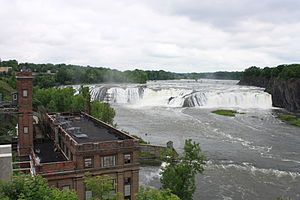
Converts 94% of the water’s energy into electricity, with 98% survival of fish
Obama administration stimulus funding for renewable energy has resulted in yet another clean energy breakthrough. This time, in hydropower, with the development of a revolutionary new turbine technology that is both fish-friendly and energy efficient.
The new turbine has now aced tests at scale that were made possible with the increase in government funding through the Department of Energy in 2009, along with the Electric Power Research Institute (EPRI) and hydropower industry partners, in a collaborative research project with the objective of completing the remaining developmental engineering required for a “fish-friendly” hydropower turbine.
The problem:
Until now, fish mortality and energy production have been mutually exclusive. Traditional, highly efficient hydro power killed or maimed fish, but more fish-friendy projects were less efficient at making electricity, losing 8,500 megawatt-hours of production a year operating separate bypasses to allow fish through unharmed.
The primary challenge for this project was to complete the requisite engineering necessary to convert a conceptual turbine design into a design that could be built and be commercially competitive with existing hydropower turbine designs. It had to be both efficient, and fish-friendly. The resulting turbine achieves this, combining converting 94% of the water’s energy into electricity, with 98% survival of fish.
How government funding helped:
The Energy Department’s hydropower division (Water.energy.gov) had initially started working with engineers and scientists at Alden Laboratories to design a fish-friendly turbine in 1995, and conceptually, it worked. Early testing at Alden’s research facility had been extremely promising, and suggested that survival rates could near 100%, and for 40,000 species of fish.
But full-scale testing would be needed, and in 2009, that is what the project got, because under the increase in funding for clean energy by the Obama administration, increased funding made possible a critical round of several years of developmental engineering and full-scale testing at the Voith Hydro Hydraulic Test Stand Facility in York, Pennsylvania. Now those full-scale tests have produced results (full technical report of prototype testing) that have exceeded expectations, with a win-win for both fish survival and energy production.
How it works:
The difference essentially is size and speed. Most conventional hydropower turbines have between five and 18 fast-spinning blades, separated by gaps. The blades can strike and injure fish, and the gaps can trap them. The Alden turbine, by contrast, has three blades, no gaps, is bigger and rotates more slowly. These measures significantly reduce the danger of trauma or death to fish passing through, yet the turbine’s larger size and other design considerations are optimized to preserve high efficiency and energy production.
Over the next three years, a demonstration of the new design using a 10 MW Alden Turbine will be tested at the Brookfield Renewable Power School Street Project in Cohoes, New York.
Why it matters for our future:
With a breakthrough like this, for the first time ever, hydropower becomes a source able to support both the clean and efficient electricity production needed to support our civilization, along with the intact ecosystem that is the basis for one.
Read more . . .
Bookmark this page for “hydro turbine” and check back regularly as these articles update on a very frequent basis. The view is set to “news”. Try clicking on “video” and “2” for more articles.







